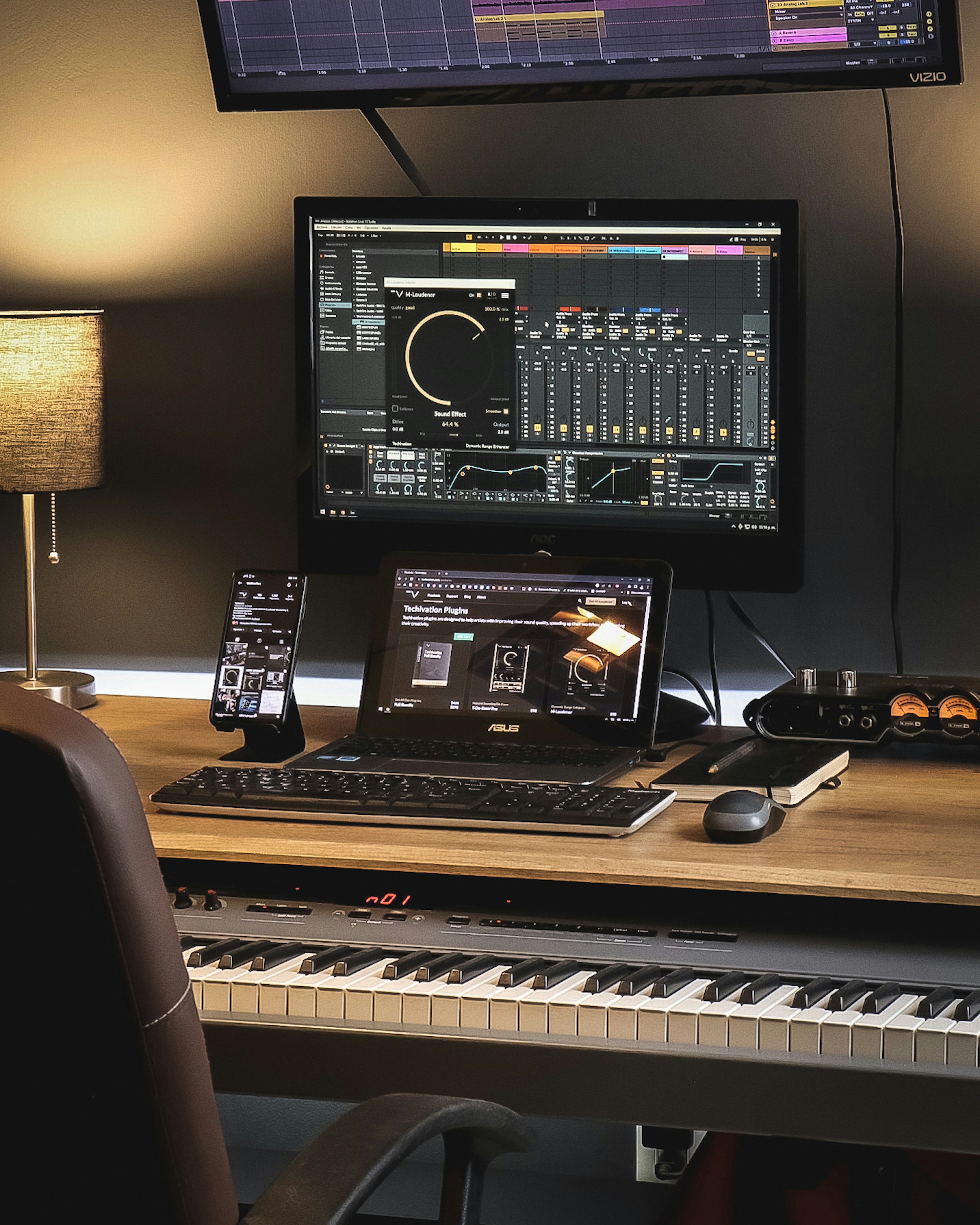
Introduction to Music and Productivity
The relationship between music and productivity has been a subject of interest in various studies, suggesting that the right musical selection can significantly enhance an individual’s concentration levels and overall work performance. Music serves not only as a form of entertainment but also as a powerful tool for fostering an optimal work environment. This is particularly true in settings that require sustained mental effort, where distractions can hinder efficiency.
Different genres of music can elicit varying responses from listeners. For instance, classical music, particularly compositions featuring string instruments, is often associated with increased concentration. This genre is believed to create a soothing atmosphere that fosters a state of flow, enabling workers to delve deeper into their tasks without succumbing to distractions. Alternatively, upbeat pop music may elevate mood and energy levels, especially in creative tasks, thereby enhancing productivity by making the work seem less laborious.
It is critical to identify the type of music that aligns with personal preferences and the demands of specific tasks. While some individuals thrive in a quiet workspace, finding a distraction-free environment is crucial, others may perform better with background music. Consequently, an understanding of how music influences mood and work dynamics is essential for maximizing productivity. The careful selection of music not only keeps the mind engaged but also helps minimize feelings of stress and fatigue, ultimately leading to improved performance outcomes.
In light of these factors, it becomes evident that music can play a pivotal role in work settings. By selecting the appropriate musical backdrop, individuals can create a conducive atmosphere that supports their focus and efficiency. The task of harnessing music for productivity involves experimentation and introspection to determine the ideal soundscape for enhancing one’s work experience.
The Science Behind Music and Its Effects on the Brain
Music has long been a subject of fascination not only for its artistic qualities but also for its profound effects on the human brain. Research in psychology and neuroscience reveals that music can significantly influence cognitive function, emotional well-being, and overall productivity. Studies have demonstrated that listening to music can stimulate several areas of the brain responsible for emotions, learning, and memory.
One of the most notable findings in this realm is the impact of music on creativity. A study conducted by the University of California found that individuals who were exposed to music while engaging in creative tasks produced more original and innovative ideas compared to those who worked in silence. This suggests that certain types of music can act as a catalyst for creative thinking, promoting divergent thought processes that are essential in various work scenarios.
Moreover, music has been shown to improve cognitive functions, including attention and memory. The “Mozart Effect,” a term coined from studies that associate listening to Mozart’s compositions with enhanced spatial-temporal reasoning, highlights how specific types of music may improve mental performance. While not all music produces the same results, quality instrumental tracks or classical music can facilitate higher levels of focus and concentration, thereby encouraging productivity.
Additionally, music plays a vital role in stress reduction. Research indicates that listening to music can lower cortisol levels, the hormone associated with stress. As a result, incorporating music into the work environment may help individuals manage stress more effectively, creating a more conducive atmosphere for productivity. The type of music chosen, whether calming tunes or upbeat rhythms, can tailor the experience based on individual preferences and tasks at hand.
In summary, the intricate relationship between music and the brain underscores the potential benefits of music in enhancing productivity and focus. By understanding these psychological and neurological effects, individuals can curate thoughtfully selected soundtracks that not only inspire creativity but also foster a positive working environment.
Genres of Music for Optimal Focus
When it comes to enhancing productivity and focus during work tasks, the genre of music plays a crucial role. Different types of music can evoke specific emotions and mental states, making them more or less effective for concentration. Among the most recommended genres for maintaining focus are classical, ambient, electronic, lo-fi beats, and natural sounds. Each of these genres exhibits unique characteristics that can help create the optimal environment for productivity.
Classical music, particularly compositions from the Baroque period, is often cited for its ability to heighten cognitive function and concentration. The works of composers such as Bach and Vivaldi, with their structured melodies and harmonious patterns, can induce a calm yet focused mindset. Studies suggest that listening to classical music can enhance creativity and promote mental clarity, making it an excellent choice for tasks that require deep thinking and concentration.
Ambient music, characterized by its minimalist soundscapes and soothing tones, provides a gentle backdrop that helps reduce distractions. This genre often lacks a distinctive beat or melody, allowing listeners to immerse themselves in a tranquil auditory environment without being overwhelmed. The atmospheric qualities of ambient music create an ideal space for focused work, enabling individuals to think deeply and maintain their concentration over extended periods.
Electronic music, particularly instrumental subgenres such as downtempo and chillwave, can stimulate productivity by adding rhythmic elements to the listening experience. The repetitive beats in electronic music promote a sense of flow, which can be beneficial while completing monotonous tasks. Additionally, lo-fi beats have gained popularity for their nostalgic sound and calming presence, making them a favorite among students and professionals alike seeking to improve their focus.
Finally, natural sounds—such as rain, ocean waves, and forest sounds—can also effectively enhance concentration. These soothing auditory elements help create a peaceful atmosphere, reducing stress and promoting a state of relaxation that is conducive to focused work. Ultimately, selecting the appropriate genre of music can significantly influence productivity and the ability to concentrate effectively.
The Role of Tempo and Rhythm in Music for Work
The tempo and rhythm of music play a crucial role in shaping the auditory landscape of a work environment. The pace at which music is delivered can significantly influence both productivity and focus levels among individuals engaged in various tasks. Research suggests that faster tempos—typically ranging from 120 to 140 beats per minute—can energize listeners, fostering an atmosphere that enhances motivation and physical movement. This invigorating effect is particularly beneficial in scenarios that demand high levels of activity or creativity, as it can lead to increased enthusiasm and a more dynamic approach to problem-solving.
Conversely, slower tempos, which can fall between 60 and 80 beats per minute, tend to cultivate a serene and calming atmosphere. These rhythms are advantageous for tasks requiring deep concentration, such as analytical thinking or detailed project work. By reducing stress levels and creating an environment conducive to focus, slower-paced music can help individuals immerse themselves in their tasks without unnecessary distractions. This becomes especially relevant in high-stakes or complex environments where the quality of output is paramount.
Personalizing Your Music Experience: Finding What Works for You
When it comes to using music as a tool for enhancing productivity and focus, personal preference plays a pivotal role. Each individual reacts uniquely to various musical genres, rhythms, and tempos, and identifying the style of music that resonates well with you can significantly impact your concentration and motivation levels during work tasks. In essence, the music you choose can either heighten your enjoyment or hinder your productivity, depending on your personal affinity for specific sounds and melodies.
To effectively personalize your music experience, it’s advisable to explore an array of musical styles. Start by considering genres such as classical, ambient, lo-fi, or even instrumental jazz. These types of music often provide a soothing background that minimizes distractions while fostering an environment conducive to deep work and creativity. You might find that certain genres spark your enthusiasm, enabling you to engage with your tasks more readily. Alternatively, you may discover that music with lyrics detracts from your ability to concentrate; hence, experimenting with vocal versus instrumental tracks can determine your ideal listening landscape.
Moreover, evaluating tempo and volume can also influence your work atmosphere. Faster tempos may invigorate and energize you, while mellow beats could promote relaxation and focus. Finding the right balance that enhances your task performance is key. It may be helpful to create playlists tailored for different activities; for example, an upbeat collection for brainstorming sessions and softer melodies for tasks requiring intense concentration. By taking the time to discover what works best for you, you can transform the way you approach work, making music an integral part of your productive routine.
Creating the Perfect Playlist for Work
Crafting an effective work playlist is essential for enhancing productivity and maintaining focus during work sessions. The right selection of music can create a stimulating yet non-distracting environment, ultimately boosting overall performance. When assembling your playlist, consider a few key elements such as song mixing, duration, and transitions.
Firstly, the mixing of genres plays a crucial role in keeping your mindset engaged without drawing too much attention away from the task at hand. Incorporating a variety of instrumental tracks, such as classical, ambient, or electronic music, can create a harmonious auditory backdrop. These genres typically exhibit steady rhythms and soothing melodies, promoting concentration while minimizing distractions. Avoiding lyrical content is recommended, as words can often divert attention from cognitive tasks.
The duration of your playlist is another important factor. Aim for a collection of songs that lasts at least one hour, ideally aligning with your work sessions. Studies suggest that people tend to work better in longer bursts, such as focused intervals of 25 to 50 minutes, followed by short breaks. A longer playlist helps ensure that the music does not abruptly end or require frequent changes, allowing for seamless continuity during work. As you curate your songs, consider mixing longer tracks with shorter ones to maintain variety while adhering to this timeframe.
Lastly, pay attention to transitions between songs. Abrupt shifts in tempo, rhythm, or style can disrupt focus and pull you out of your workflow. Smooth transitions are vital for cultivating an uninterrupted experience. Techniques such as crossfading, where one song gently blends into another, can create a more organic auditory flow. By following these guidelines, it is possible to build a work playlist that maximizes productivity and enhances focus, providing a conducive environment for sustained work sessions.
Transparent Listening: The Impact of Lyrics on Work Efficiency
When it comes to selecting music for enhanced productivity, the presence of lyrics in songs can have a significant impact on work efficiency. While some individuals find that lyrical content distracts from tasks that require concentration, others may derive motivation and stimulation from engaging lyrics. This dichotomy in preference stems from the varying personal responses to auditory stimuli. For example, those involved in creative work often favor tracks with lyrics, as the words can resonate and inspire ideas, fostering deeper engagement with their tasks.
In contrast, individuals who perform tasks requiring intense focus, such as data analysis or programming, may find that lyrics compete with their cognitive processes. Research shows that verbal tasks and lyrics can create conflicting demands on the brain, leading to decreased productivity. As such, it is advisable for these workers to consider instrumental music or ambient sounds, which can provide a conducive auditory environment without the distractions associated with words.
The nature of the work also influences choice. For routine tasks that require a lower level of cognitive engagement, songs with clearly articulated lyrics may provide an enjoyable backdrop, enhancing motivation and even improving morale. On the other hand, tasks that need deep focus and analytical thinking will generally benefit from the absence of lyrics, allowing for a smoother flow of thought and decision-making. Ultimately, the decision to incorporate lyrics into one’s work soundtrack should depend on an individual’s specific tasks and their personal preferences regarding auditory engagement.
In summary, understanding the impact of lyrics on productivity requires a nuanced approach. Individuals should experiment with different styles of music, tailoring their choices to align with the demands of their work, thus optimizing their overall efficiency and focus.
Cultural and Contextual Influences on Music Choices
Music choices are profoundly influenced by cultural backgrounds and the specific context in which individuals find themselves. Different cultures have distinct musical traditions that shape preferences and listening habits. For instance, in many Western societies, genres such as classical, jazz, and contemporary pop music are often favored in work environments, as they are perceived to enhance focus and concentration. Conversely, in cultures with rich heritage in traditional forms, such as African drumming or Indian classical music, individuals may gravitate towards these sounds as they evoke a sense of familiarity and comfort while working.
The context of the work environment also plays a crucial role in shaping music preferences. In open-plan offices, where distractions are prevalent, employees might opt for instrumental music or ambient sounds, as they often lack lyrics and reduce the potential for distraction. In contrast, those working from home may favor more upbeat genres, such as electronic dance music, which can enhance motivation during physically demanding tasks, such as exercising or engaging in creative projects. The distinction extends beyond the nature of work; even the time of day can sway one’s musical choices. For instance, calm and soothing melodies might be preferred in the early morning hours, while energetic tunes may become popular as the day progresses and the need for heightened focus and motivation increases.
Furthermore, individual backgrounds play a significant role in music selection for work. Factors such as age, education, and exposure to various musical genres can greatly influence how one perceives and utilizes music in a work setting. Millennials, for instance, might lean more towards playlists featuring contemporary hits or lo-fi hip-hop, while older generations may prefer classic rock or folk music. Understanding these cultural and contextual influences on music choices is essential for organizations aiming to create an environment conducive to productivity, as facilitating a diverse range of musical options can cater to the varied preferences of employees, ultimately enhancing focus and performance.
Conclusion: Harmonizing Music, Mind, and Work
In exploring the intricate relationship between music, productivity, and focus, it becomes evident that the right auditory environment can significantly enhance one’s work experience. The discussion has highlighted various genres and styles, illustrating how they can either stimulate or calm the mind, directly influencing work output. While some may thrive on energetic beats to fuel their creativity, others may find solace in classical compositions that promote a tranquil setting for deep concentration.
The core takeaway from our exploration is that music is a deeply personal element; what resonates with one individual may not necessarily appeal to another. This underscores the importance of personal experimentation. By curating a selection of diverse musical pieces—from lo-fi hip-hop to ambient soundscapes—individuals can discover the soundtracks that best align with their work habits. Additionally, it’s worth noting that external stimuli, including environmental noise, can affect how music influences focus and productivity, suggesting a need for adaptive listening strategies based on the nature of the task at hand.
Furthermore, integrating music into work routines can usher in a dynamic shift in motivation and efficiency. As individuals navigate different projects, they should remain open to adjusting their musical choices, allowing for the gradual refinement of their unique working soundtrack. In conclusion, the harmonization of music, mind, and work is a journey that invites engagement and adaptability, ultimately paving the way for enhanced focus and productivity. By embracing music as a tool in the workspace, individuals can unlock their full potential and create a more enjoyable and effective work atmosphere.






